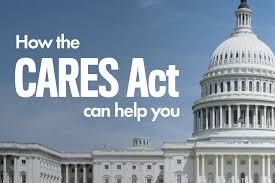ELIGIBILITY REQUIREMENTS FOR LOCAL GOVERNMENTS TO RECEIVE CARES ACT FUNDS
This week, the SB 310 language distributing federal CARES Act coronavirus relief revenues to local governments was amended into HB 481 on the Senate floor and passed. The bill was then sent to the House, where it was concurred upon unanimously and is now being sent to the Governor for his signature, where it will become effective immediately due to the bill’s emergency clause.
The language amended into HB 481 appropriates and authorizes distribution of $350 million of federal CARES Act funding to Ohio communities for COVID-19 expenses. The distribution in HB 481 does not apply those local governments who received a direct payment from the Coronavirus Relief Fund (Fund 5CV1) .
Payments from the Coronavirus Relief Fund can only be used to finance costs that:
- Are necessary expenditures incurred due to the public health emergency with respect to COVID-19;
- Were not accounted for in the budget most recently approved as of March 27, 2020 for the state or government; and
- Were incurred during the period beginning March 1, 2020 and ending December 30, 2020
In the language, “necessary expenditures incurred due to the public health emergency with respect to COVID-19″ include :
- Costs incurred to respond directly to the public health emergency, such as addressing medical or public health needs, or payroll costs for public health and public safety employees are presumed to be payments for services substantially dedicated to COVID-19
- Costs incurred to respond to second-order effects of the public health emergency, such as providing support to address employment or business interruptions. The funds may not be used to replace revenue for expenditures that would not otherwise be eligible
- Expenditure is reasonably necessary for its intended use in the reasonable judgment of the government officials responsible for spending Fund payments
The bill’s requirement for costs “not accounted for in the budget most recently approved as of March 27, 2020 for the State or government ” is met if either:
- Cost cannot lawfully be funded using a line item, allotment, or allocation within the budget; or
- Cost is for a substantially different use from any expected use of funds within such line item, allotment, or allocation.
The budget “most recently approved” means the relevant budget enacted for the relevant fiscal period, not including supplemental appropriations or other budget adjustments. A cost is not considered to have been accounted for merely because it could be met using budgetary stabilization, rainy day fund, or similar reserve account.
Eligible costs must have been incurred during the period beginning March 1, 2020 and ending December 30, 2020. The means the government has expended funds during the period March 1, 2020 to December 30, 2020 (i.e., must actually be spent – appropriated for use would not be sufficient).
Examples of eligible expenditures include:
- Costs of providing COVID-19 testing;
- Expenses of communication and enforcement of public health orders;
- Expenses for disinfection of public areas and other facilities (e.g., nursing homes);
- Expenses for PPE and sanitizing products for medical personnel, police officers, social workers, child protection services, etc. in connection with COVID-19;
- Expenses for technical assistance to local authorities or other entities on mitigation of COVID-19 threats to public health and safety;
- Payroll expenses for public safety, public health, health care, human services, etc., whose services are substantially dedicated to mitigating or responding to COVID-19;
- Expenses to provide paid sick and family leave to public employees to enable compliance with COVID-19 public health precautions;
- Expenses for emergency financial assistance to individuals and families directly impacted by loss of income due to COVID-19;
- Expenditures related to grants to small businesses to reimburse costs of business interruption caused by required closures.
Examples of ineligible expenditures include :
- Payroll or benefits expenses for employees whose work duties are not substantially dedicated to responding to COVID-19;
- Expenses that have been or will be reimbursed under any federal program;
- Severance pay;
- Legal settlements;
- Damages covered by insurance;
- Expenses for the state share of Medicaid;
- Reimbursement to donors for donated items or services;
- Assistance for property tax requirements;
- Workforce bonuses other than hazard pay or overtime paid to employees whose services are substantially dedicated to mitigating/responding to COVID-19.
Local governments are responsible for making determination as to what expenditures are necessary due to public health emergency and are not required to submit any proposed expenditures to Treasury. Fund payments are considered federal financial assistance for the purposes of the Single Audit Act. Fund payments also subject to federal regulations concerning subrecipient monitoring and management.
The legislative authority of each county, municipal corporation, and township must first adopt legislation affirming that funds received may be spent only to cover costs consistent with CARES Act requirements. The is the sample resolution from the Office of Budget and Management, which you can find HERE. Funds will not be distributed from the Coronavirus Relief Fund until such legislation is adopted. Legislative authorities must also certify a copy of such legislation to the county auditor and Director of Budget and Management.
On the county level, each county auditor must create a new fund to be named the County Coronavirus Relief Distribution Fund. The Director of Budget and Management, in consultation with the Tax Commissioner, provides for payment from the Coronavirus Relief Fund to each County Coronavirus Relief Distribution Fund.
Within seven days of deposit in each County Coronavirus Relief Distribution Fund, county auditors must divide funds and distribute payments to counties, municipalities and townships. Upon making such distribution, county auditors must report the amount distributed to each subdivision to the Director of Budget and Management.
As for municipalities, each local fiscal officer must establish a new fund to be named the Local Coronavirus Relief Fund. Within seven days of deposit in each County Coronavirus Relief Distribution Fund, county auditors must distribute payments to eligible municipal corporations and townships.
In addition to this information, you can find the latest FAQ from the U.S. Treasury on how the funds can be used HERE.

